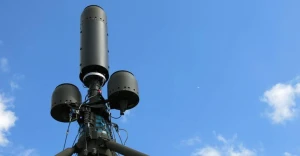
October 2-9 live war map: Russian forces change focus, next targets are Kurakhove, Velyka Novosilka
Following Vuhledar’s capture, Russian forces' activity has subsided across most areas of the frontline, except for the Kupyansk and Kurakhove directions, and fighting in Toretsk. Russia is likely changing its immediate priority goals on the fly, aiming to achieve them in the short term before the year’s end
Kurakhove and Velyka Novosilka are key to southern Donetsk frontline
Given that the battle for Pokrovsk is expected to be prolonged and may not yield favorable results for Russia, Russian troops have apparently opted for a significant bypass maneuver. Their goal seems to be reaching the border of Donetsk and Dnipropetrovsk regions near Velyka Novosilka. From there, they would likely advance toward Kurakhove and Pokrovsk, aiming to infiltrate the rear of the Ukrainian Defense Forces.
Currently, Russian troops have concentrated their efforts on two key offensive areas in the southern part of the Kurakhove front: Zolota Nyva, which was retaken by Ukraine in 2022, and the villages of Bohoyavlenka and Novoukrainka. While Ukraine's 72nd Brigade, which withdrew from Vuhledar, is holding the line and preventing further Russian advances in the latter two areas, Russian troops have made some gains near Zolota Nyva. They have managed to approach the outskirts of the village and crossed the fields to the south. As a result, part of Zolota Nyva is now in the gray zone, although the Ukrainian Armed Forces maintain control of the center and west of the village. Russian forces have yet to cross the Kashlahach River, which serves as a significant barrier to their advance. However, in the future, they may reinforce their positions by bringing additional forces from the Prechystivka-Novoukrainka area, where they have already managed to force the river. They still have 11 kilometers to go to Velyka Novosilka. The main task of Ukraine's Defense Forces is to delay the Russian advance as much as possible, aiming to hold the line until the onset of the rainy season. Once the weather deteriorates, movement in this part of the front will become extremely difficult, significantly slowing the pace of the Russian offensive.
The Russians are also aware of this and are accelerating their actions, while simultaneously engaging neighboring areas of the frontline to conduct distracting attacks. In particular, there was a concentration of Russian troops near Polohy, excessive activity near Robotyne, and an attempt to storm the northern part of Kamianske, near Zaporizhzhia.
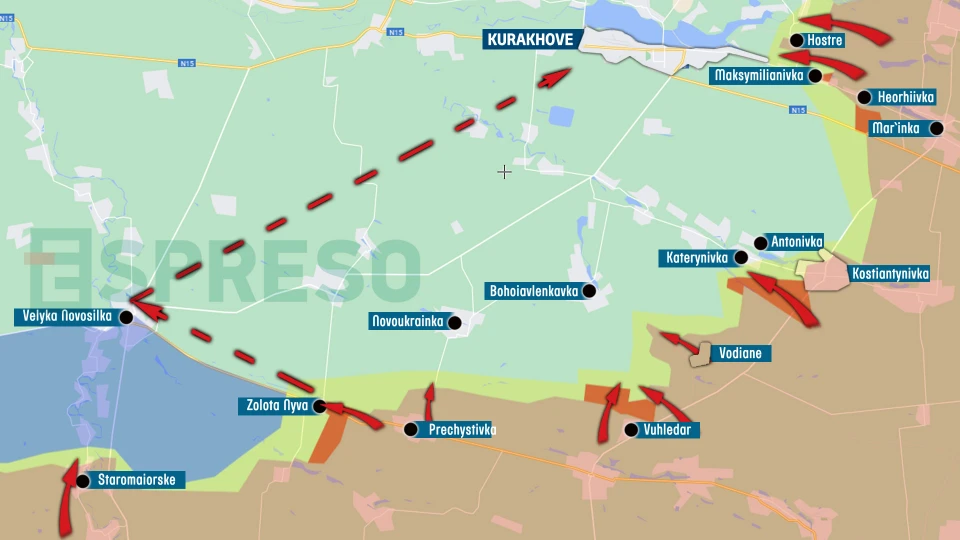
Photo: Espreso map of hostilities for October 2-9
On the southeastern section of the Kurakhove front, Russian troops are attempting to expand their control around Vodiane and south of Katerynivka, making notable advances this week along the northern bank of the reservoir on the Solodka River. As a result, street battles are expected to soon unfold in Katerynivka, placing the Ukrainian Defense Forces in a challenging position, as they will be surrounded by two rivers. To counter this, a new defense line will likely need to be established along the Sukhi Yaly River.
However, the most dangerous situation is developing directly near Kurakhove. Here, Russian troops are attacking daily through the villages of Maksymilianivka and Hostre. Currently, the Russian advance is minimal but steady on a daily basis. They have already occupied the eastern quarters of Maksymilianivka and are close to the village of Ostrovske, 1.5 km from Kurakhove. However, Kurakhove is protected from the north by a reservoir on the Vovcha River, which will become an insurmountable obstacle for Russian forces, and therefore they would be forced to pull up their southern flank or break through head-on, which will take many months.
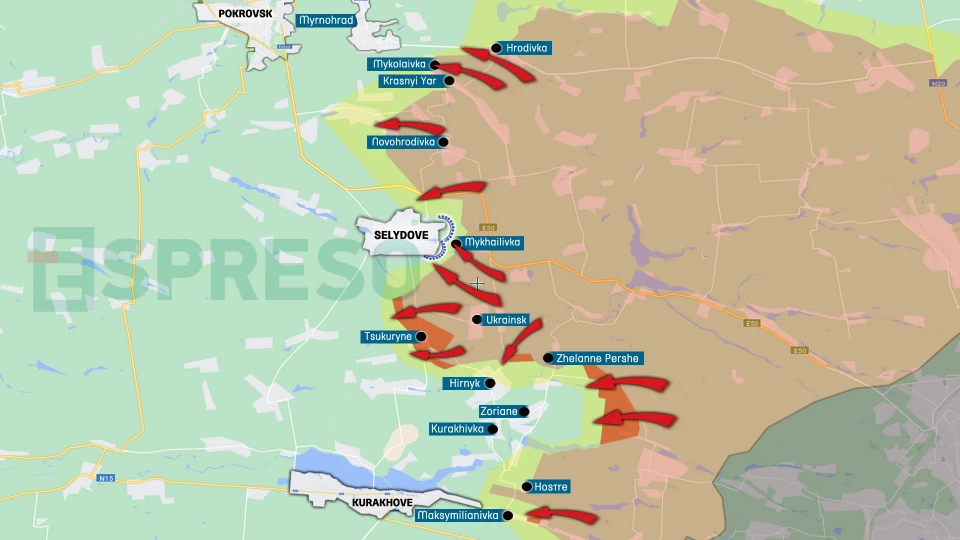
Pokrovsk front keeps stagnating
Russia's only notable success in this area has been the near-total occupation of Tsukuryne, a process that took more than two weeks. Currently, the front line runs along the railroad in the western quarters of the town. However, Russian troops have managed to cross the railroad and advance toward Izmailivka, beginning to threaten Hirnyk from the western side. To the north of Tsukuryne, Russian forces are preparing a foothold for an offensive on the southern districts of Selydove, as they have been unable to enter the town from the east for over a month.
At the same time, they are also preparing to move on Selydove from the north, but the Russian offensive has slowed down considerably, first in Marynivka and then beyond. The pace of the Ukrainian Armed Forces' defense in the Nevelske pocket is also not encouraging for the occupying forces, as instead of a rapid collapse of the front, Ukrainian Defense Forces have been retreating slowly for several weeks and conducting successful rearguard battles. This week, Ukrainian troops retreated 2.5 kilometers along this section of the frontline only after the final loss of their last positions in occupied Krasnohorivka. Ukrainian soldiers still have over 4 kilometers to go before they are completely out of the pocket and can gain a foothold on the right bank of the Vovcha River near Zoriane.
Meanwhile, one of the reasons for slowing down the offensive in the Pokrovsk direction is the successful destruction of Russia’s three command and control headquarters located at the Avdiivka railway and concrete plants by Ukrainian missiles and HIMARS. The headquarters of the 2nd Combined Arms Army, the 27th Motorized Rifle Division, and the 35th Motorized Rifle Brigade were blown up.
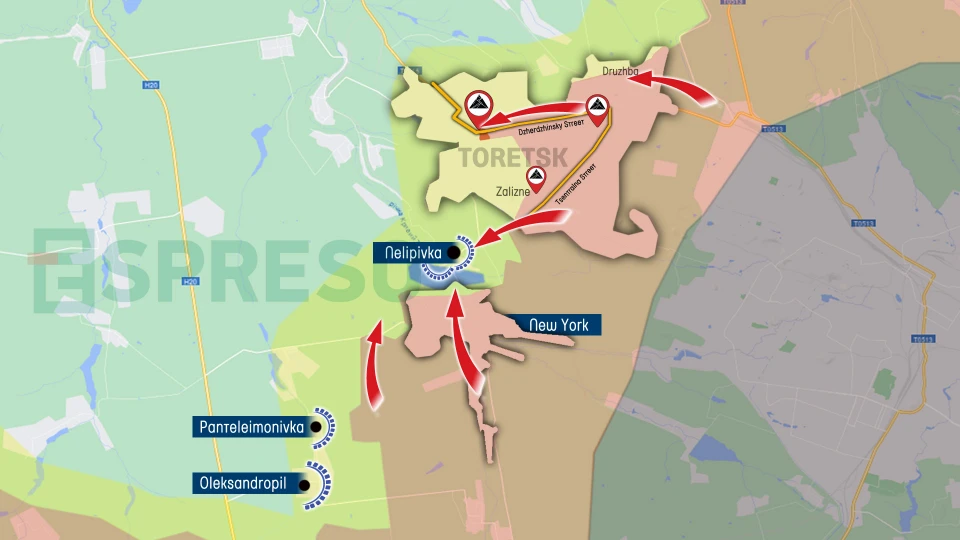
Battle for Toretsk town center
Russia's advance on both the southern and northern flanks of Toretsk has effectively stalled. Intense fighting continues in Nelipivka and on the outskirts of Druzhba, but the situation in the town itself remains dire. The central streets are the focus of heavy combat, with buildings changing hands multiple times. Despite this, the Ukrainian Armed Forces are holding firm, launching constant counterattacks and often resorting to destroying buildings to eliminate invading troops inside. Meanwhile, Russian forces are sending wave after wave of suicide “cannon fodder” in a desperate attempt to break through.
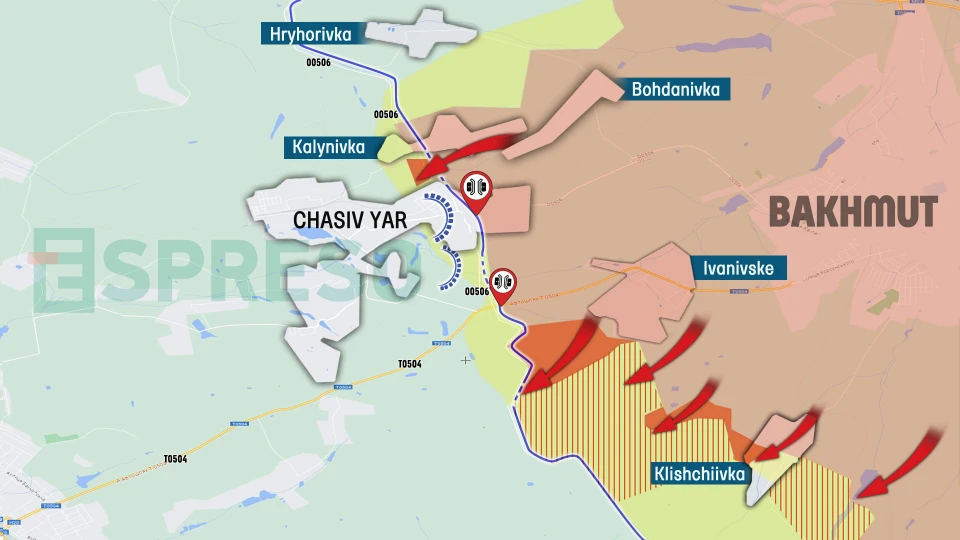
Chasiv Yar faces a growing threat of bypass from south and north
In the area of Kalynove, on the northern outskirts of the city, Russian forces have once again secured a small bridgehead on the right bank of the Siverskyi Donets Canal. However, the Ukrainian Defense Forces have repeatedly pushed them back or destroyed their positions, preventing them from establishing a firm foothold. The more concerning development is on the southern flank, where Russian forces have been making a slow but steady advance in recent weeks around the strategic heights near Klishchiivka and from the direction of Ivanivske. These heights are crucial for the Ukrainian Armed Forces, as they have allowed Ukraine to contain the Russian offensive and block a potential bypass of Chasiv Yar from the south. Losing control of these heights would open the door for Russian forces to exploit this vulnerability. While Klishchiivka has not yet been fully lost, the situation is increasingly threatening.

Russia rushes to Luhansk region borders and Oskol River
The situation on the border of Luhansk and Kharkiv regions deteriorated even further over the week. Russian forces came close to Kruhliakivka. The battle for the village on the left bank of the Oskol River is likely to begin in the coming days. It is from this place that Russia plans to expand its presence along the river, both to the north, to Kupyansk, and to the south, to Borova. Around Pishchane, the Russian aggressor has strengthened the flanks of its daggerboard. Now it will be even harder for the Ukrainian Armed Forces to cut it off.
In addition, Russian forces have captured the last remaining villages in the Luhansk region—Andriivka, Miasozharivka, and Stelmakhivka—where intense fighting continued throughout September. The situation in Andriivka is particularly alarming, as Russian troops have managed to cross the Zherebets River at another location. Ukrainian defenses along the river have effectively collapsed, and it appears inevitable that Ukrainian forces will be forced to fully retreat from this part of the Luhansk region. They will likely need to establish a new defensive line around Borova to prevent further Russian advances.
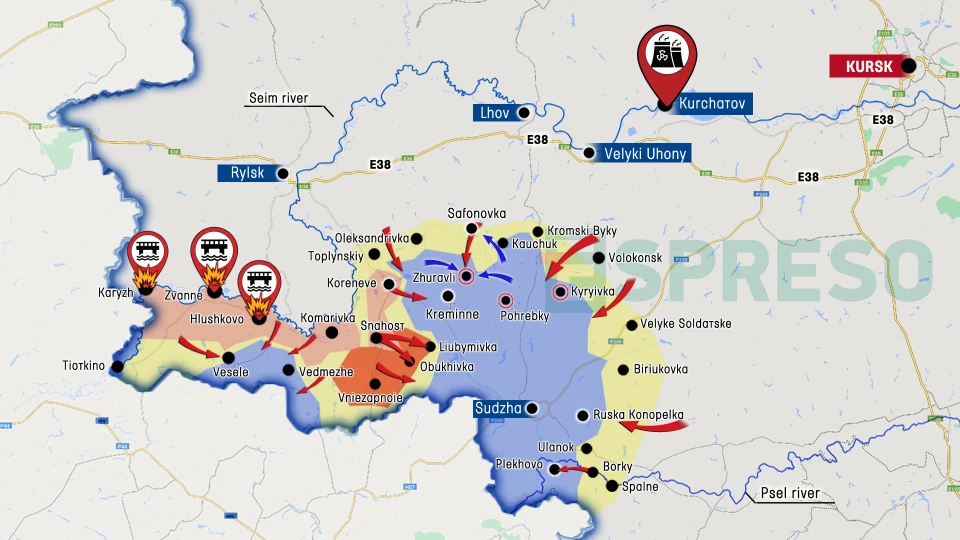
Kursk operation is 2 months old
As the Russian contingent in the Kursk region grows, territorial changes have slowed, despite Russian forces launching the third phase of their counteroffensive across nearly all fronts. Russia's only minor successes include the capture of Obukhovka and their advance into Liubymovka, where street fighting is currently ongoing. Additionally, Russian forces have intensified pressure in the direction of Vnezapnoe - Darino, although Ukrainian positions there have remained stable. Meanwhile, the Ukrainian Armed Forces have reduced their pressure on Glushkovo, as they are now focused on repelling Russian attacks. The Russians have managed to establish logistical routes through Korenevo, despite the destruction of bridges and pontoon crossings on the Seim River.
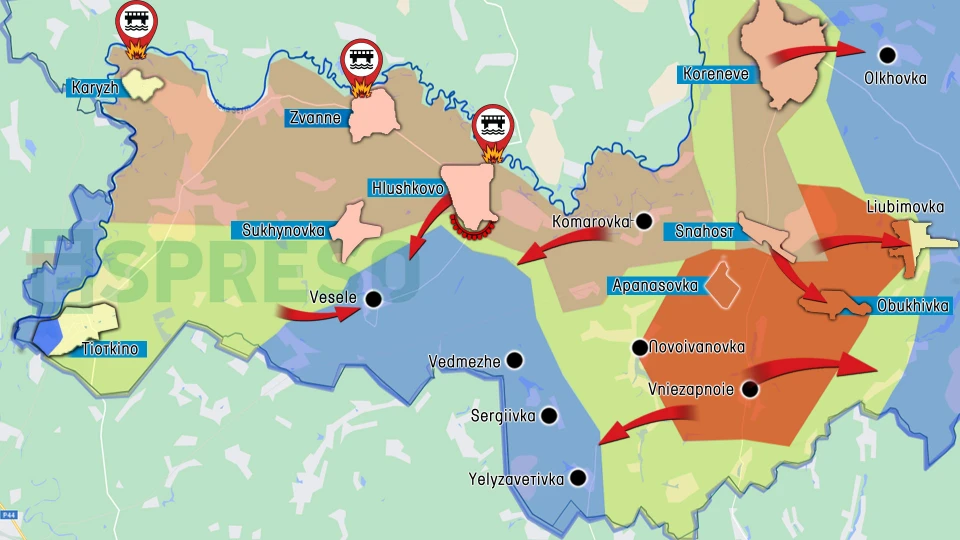
At the same time, the Ukrainian Armed Forces keep using maneuver warfare tactics. A vivid example of this is the Ukrainian offensive in the Safonovka area while Russian troops are trying to advance in the Kremyanoe area, where several of their groups are blocked. The trend of fighting over the past two months shows that the situation is developing in such a way that Kursk residents will probably celebrate the New Year with a new president.
The maps were created using data from the General Staff of Ukraine’s Armed Forces and other verified sources. However, they are approximate and primarily reflect trends in the war zone.
- News








